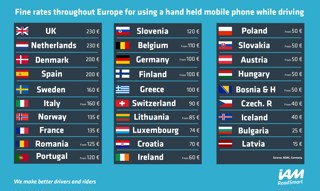Businesses need to urgently tackle the issue of distracted drivers and overhaul their safety at work policies to help stem the tide of avoidable crashes on our roads, says IAM RoadSmart.
The road safety charity has just published a white paper called Driving While Distracted: Challenges and Solutions, which examines the reasons why so many motorists’ minds wander while driving, and what can be done to reverse the trend.
Department for Transport figures show that in 2017 there were 4,639 casualties caused by in-vehicle distractions.
Driver distraction can take four forms, the report says, mental, visual, manual and through sound.
The growing trend of ‘nomophobia’ – the fear of being out of mobile phone contact – is particularly prevalent among business drivers but employers can avoid it through consistent application of a mobile phone policy among their drivers, says IAM RoadSmart.
The advent of new Advanced Driver Assistance Systems (ADAS), which can tempt us to drive as a passenger one minute and retake control the next, are all adding to the need to ensure fleet managers take distraction seriously, it says.
Dr Graham Hole from Sussex University says that there is a particular concern with semi-autonomous driving where “humans are rubbish at being vigilant”.
In terms of an answer to the problem of distracted motorists, the IAM RoadSmart report states that the ideal solution – the fully autonomous car – is still some way off.
The report concludes that businesses have to ask some long hard questions and have a robust company driver training policy that is adhered to by drivers.
Tony Greenidge, IAM RoadSmart business development director, said: “Our white paper shows that with increasing the sophistication of in car technology there is an unintended consequence that requires drivers – typically in real time - to decide how to best process and utilise the information provided.
“Employers also have a key role to play by ensuring that their travel and mobility policies allow drivers to take full advantage of technology but in a way that is both safe and legal.”
To download the full report, click here.























Login to comment
Comments
No comments have been made yet.